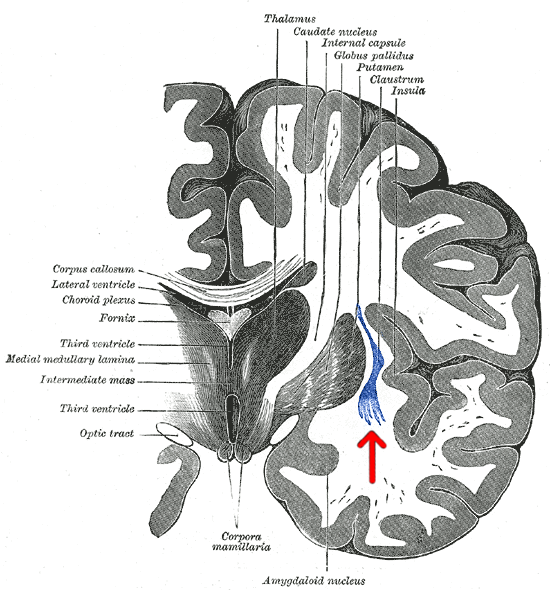Researchers: The Brain’s Claustrum Acts as a Router for Thoughts
Francis Crick thought the claustrum might be the “seat of consciousness,” an inherently materialist concept. The researchers think he was wrong.Remember Francis Crick (1916–2004) and The Astonishing Hypothesis (1994)?: “You, your joys and sorrows, your memories and ambitions, your sense of personal identity and free will are, in fact, no more than the behaviour of a vast assembly of nerve cells. As Lewis Carroll’s Alice might have phrased it: ‘You’re nothing but a pack of neurons’.”

Crick focused on the brain region known as the claustrum as closely tied to consciousness. According to University of Maryland medical researchers, he thought of it as the “seat of consciousness.”
Now, the very concept of a “seat of consciousness” assumes that consciousness is a material thing that needs a seat. In other words, consciousness must be found specifically in one place and not another. But there is no reason — apart from a passionate commitment to materialism, such as Crick experienced — to see consciousness as needing a seat.
Consciousness is surely related to the brain rather than the elbow. But the exact relationship is difficult to research because consciousness is immaterial. There are material correlates to what we think but they may be spread throughout the brain and they may operate in a constant state of flux. Significantly, many people are conscious with half a brain or other major anomalies — which should serve as a warning against seeing consciousness as merely a “pack of neurons.”
At any rate, the medical researchers think that Crick didn’t understand how the claustrum in humans and animals actually works. Based on their studies, they propose a different model: “The brain’s claustrum, receives, amplifies, and broadcasts an ‘Internet network’ required to complete complex cognitive tasks”:
They developed a new theory — built on data — that the claustrum behaves more like a high-speed internet router, taking in executive commands from “boss” areas of the brain’s cortex that forms complex thoughts to generate “networks” in the cortex. Acting like a router, the claustrum coordinates these networks to work together to accomplish the many different cognitively demanding tasks we perform on a moment-to-moment basis in everyday life.
University of Maryland School of Medicine, “Brain area thought to impart consciousness, behaves instead like an Internet router ” at ScienceDaily (November 22, 2022)
Part of their evidence involved mice:
In an effort to identify the precise role of the claustrum, Dr. Mathur and his colleagues conducted a serious of experiments on both animals and people. One experiment used modern neuroscience approaches to turn off the claustrum in conscious mice. These mice didn’t lose consciousness and kept running around normally. One strike against Crick’s theory!
Next, the researchers gave mice a cognitively simple or a difficult task and compared how they responded when the claustrum was turned off. Normally, a mouse can perform both the simple and the difficult tasks. Yet, when the researchers turned off the claustrum, the mice could no longer perform the difficult task.
Wondering if this finding had any relevance to humans, Dr. Mathur collaborated with his colleagues David Seminowicz, PhD, Professor of Neural and Pain Sciences at the UM School of Dentistry, and Fred Barrett, PhD, Associate Professor of Psychiatry and Behavioral Sciences at Johns Hopkins University School of Medicine. The three organized a research study where they conducted functional MRI brain scans on healthy volunteers who were engaged in either simple or complicated mental tasks. The researchers observed that their claustrum only “lit up” when performing the difficult version of the task. This event coincided with the activation of a network in the cortex involved in optimal cognitive performance. Strike two against Crick’s consciousness theory!
University of Maryland School of Medicine, “Brain area thought to impart consciousness, behaves instead like an Internet router ” at ScienceDaily (November 22, 2022)
The significance of their research is not simply to show that Crick was mistaken. Disorganized networks feature in many diseases, including Alzheimer and schizophrenia. If the claustrum is causing problems by functioning poorly as a “router,” the finding might point to possible treatment approaches.
Of course, seeing the claustrum as a router is more consistent with the immaterial nature of consciousness than seeing it as a seat. After all, the ideas we express in our e-mails — although they are embodied in physical systems — are fundamentally immaterial ideas. The router doesn’t create them; it just gets them to the right address — we hope.
The paper is open access.
You may also wish to read: Is consciousness a controlled brain hallucination? No. Anil Seth explains away consciousness away using fashionable terms like that. As a pediatric neurosurgeon, I know from clinical experience that he is wrong. Children born without brain hemispheres are conscious; only a dualist or idealist perspective on the brain-mind relationship can explain that fact. (Michael Egnor)
